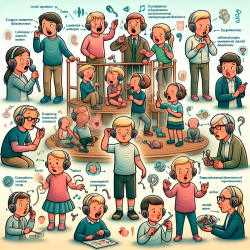Unlocking the Secret to Vocabulary Success for Children with Autism Using Technology!
Hey there, fellow educators and therapists! I’m excited to share some insights from a fascinating systematic review titled The use of technology-assisted intervention in vocabulary learning for children with autism spectrum disorder: a systematic review. If you’re working with children on the autism spectrum, you’ll want to hear about these findings and how you can incorporate them into your practice.
Why Vocabulary Development is Crucial
We all know that children with autism spectrum disorder (ASD) often face challenges in developing their vocabulary. This can impact their communication skills and overall academic success. So, how can we help them? The answer might be right at our fingertips—literally!
Technology to the Rescue
The review looked at various studies from 2006 to 2022 and found that technology-based interventions, such as tablets and computers, can be effective tools for teaching vocabulary to children with ASD. Here are some key takeaways:
- **Positive Impact:** Many studies showed that using tablets and computers helped children with ASD improve their vocabulary skills.
- **Personalization is Key:** The success of these interventions often depended on personalized assessments and taking into account the child’s previous experiences and context of usage.
- **Mixed Results:** While some children showed significant improvement, others had mixed or no results, highlighting the need for individualized approaches.
Practical Tips for Practitioners
Based on the findings, here are some practical tips you can implement in your practice:
- Start with an Assessment: Evaluate the child’s current vocabulary skills and their familiarity with technology.
- Choose the Right Tools: Tablets and computers can be very effective, but the choice of software or app is crucial. Look for ones that offer interactive and engaging content.
- Personalize the Experience: Tailor the intervention to the child’s needs. For instance, some children might benefit from more visual aids, while others might need auditory cues.
- Monitor Progress: Keep track of the child’s progress and adjust the intervention as needed. Regular feedback can help you fine-tune your approach.
- Involve Parents and Teachers: Collaboration is key. Ensure that parents and teachers are on board and can support the child’s learning journey at home and in school.
Encouraging Further Research
The review also highlighted the need for more detailed studies to pinpoint the precise conditions under which technology-based interventions can offer the most advantages. If you’re passionate about this field, consider contributing to this growing body of research.
To read the original research paper, please follow this link: The use of technology-assisted intervention in vocabulary learning for children with autism spectrum disorder: a systematic review.
Final Thoughts
Seeing students progress is one of the most rewarding parts of our job. By integrating technology into our interventions, we can unlock new avenues for helping children with ASD develop their vocabulary and communication skills. Let’s embrace these tools and continue to make a difference, one word at a time!










